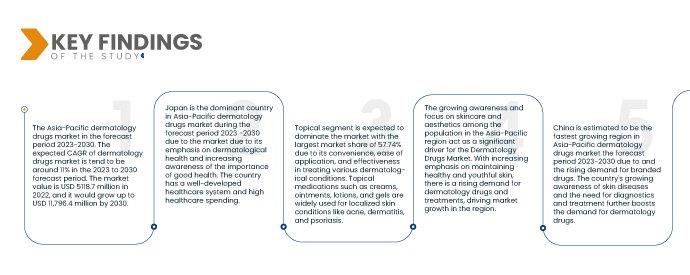The dermatology drugs industry has witnessed significant growth in recent years, driven by the increasing expenditure on skincare and growing awareness of skin diseases. There has been a notable rise in demand for dermatology drugs, particularly in emerging countries, where healthcare spending is on the rise. The growing focus on diagnostics and treatment for various skin conditions has further contributed to the expansion of the dermatology drugs market.
Access full Report @ https://www.databridgemarketresearch.com/es/reports/asia-pacific-dermatology-drugs-market
Data Bridge Market Research analyses that the Asia Pacific Dermatology Drugs Market expected CAGR of dermatology drugs market tends to be around 11% in the forecast period of 2023 to 2030. The market value is USD 5,118.7 million in 2022, and it would grow up to USD 11,796.4 million by 2030. The increasing prevalence of dermatological diseases, such as acne, dermatitis, psoriasis, and skin cancer, acts as a significant driver for the Asia-Pacific Dermatology Drugs Market. The rising incidence of these conditions, coupled with the growing awareness and importance of skincare, fuels the demand for effective treatments.
Key Findings of the Study
The availability of advanced diagnostic techniques is expected to drive the market's growth rate
The availability of advanced diagnostic techniques, such as molecular diagnostics, genetic testing, and imaging technologies, plays a vital role in driving the Asia-Pacific Dermatology Drugs Market. These advanced techniques enable accurate and early diagnosis of dermatological conditions, leading to timely and targeted treatment interventions. The use of advanced diagnostics helps healthcare providers make informed decisions about prescribing dermatology drugs, thereby driving the demand for these medications in the market.
Report Scope and Market Segmentation
|
Report Metric
|
Details
|
|
Forecast Period
|
2023 to 2030
|
|
Base Year
|
2022
|
|
Historic Years
|
2021 (Customizable to 2015-2020)
|
|
Quantitative Units
|
Revenue in USD Million, Volumes in Units, Pricing in USD
|
|
Segments Covered
|
Dermatological Diseases (Acne, dermatitis, Psoriasis, Skin Cancer, Others), Drug Class (Corticosteroids, Retinoids, Monoclonal Antibodies, Antibiotics Agent, Antiviral Agents, Antifungal Drugs, Antihistamines Agents, Immunosuppressive Drugs, Others), Drug Type (Branded, Generics), Prescription Mode (Prescription Based Drugs, Over-The-Counter Drugs), Route of Administration (Oral, Topical, Parenteral), Distribution Channel (Hospital Pharmacy, Retail Pharmacy, Online Pharmacy, Others)
|
|
Countries Covered
|
China, Japan, India, South Korea, Singapore, Malaysia, Australia, Thailand, Indonesia, Philippines, Rest of Asia-Pacific (APAC) in the Asia-Pacific (APAC)
|
|
Market Players Covered
|
LUPIN (India), Novartis AG (Switzerland), F. Hoffmann-La Roche Ltd (Switzerland), Pfizer Inc. (U.S.), Sanofi (France), Amgen inc. (U.S.), Lilly (U.S.), AstraZeneca (U.K.), AbbVie Inc (U.S.), Johnson & Johnson Private Limited (U.S.), LEO Pharma A/S (Denmark), Merck & Co., Inc (U.S.), Bausch Health Companies Inc (Canada) and Bristol-Myers Squibb Company (U.S.)
|
|
Data Points Covered in the Report
|
In addition to the insights on market scenarios such as market value, growth rate, segmentation, geographical coverage, and major players, the market reports curated by the Data Bridge Market Research also include depth expert analysis, patient epidemiology, pipeline analysis, pricing analysis, and regulatory framework.
|
Segment Analysis:
The dermatology drugs market is segmented on the basis of drug class, dermatological diseases, prescription mode, route of administration, and distribution channel.
- On the basis of drug class, The dermatology drugs market is segmented into corticosteroids, retinoids, monoclonal antibodies, antibiotics agent, antiviral agents, antifungal drugs, antihistamines agents, immunosuppressive drugs, others. corticosteroids segment is expected to dominate the market with the largest market share of 30.19% due to their wide range of applications and effectiveness in treating various skin conditions in the for caste period of 2023 to 2030
In 2023 corticosteroids segment dominates the drug class segment in the Asia-Pacific dermatology drugs market
In 2023 corticosteroids segment dominates the drug class segment in the Asia-Pacific dermatology drugs market with the market share of 30.19% due to their wide range of applications and effectiveness in treating various skin conditions. These drugs have potent anti-inflammatory and immunosuppressive properties, making them highly effective in managing dermatological disorders such as eczema, psoriasis, and dermatitis. Their ability to reduce inflammation and alleviate symptoms has led to their widespread use and dominance in the Asia-Pacific region in the forecast period of 2023 to 2030.
- On the basis of drug type the dermatology drugs market is segmented into branded, generics. Branded segment is expected to dominate the market with the largest market share of 73.62% due to the strong brand recognition and trust associated with these products. Branded dermatology drugs are often backed by extensive research, clinical trials, and marketing efforts, which instil confidence in healthcare professionals and patients in the forecast period of 2023 to 2030.
- On the basis of dermatological diseases the dermatology drugs market is segmented into acne, dermatitis, psoriasis, skin cancer, others. The dermatitis segment dominate the dermatology drugs market including atopic dermatitis and contact dermatitis, is highly prevalent in the region. The rising incidence, coupled with increasing awareness and a growing focus on skincare, drives the demand for dermatology drugs targeting dermatitis in the forecast period of 2023 to 2030.
- On the basis of prescription mode the dermatology drugs market is segmented into prescription based drugs, over-the-counter drugs. Prescription based drugs segment is expected to dominate the market with the largest market share of 94.92% due to the nature of dermatological conditions requiring professional diagnosis and treatment. Prescription drugs are prescribed by healthcare providers based on individual patient needs, ensuring appropriate treatment and monitoring in the forecast period of 2023 to 2030
- On the basis of route of administration, the dermatology drugs market is segmented oral, topical, and parenteral. The topical segment is expected to dominate the market with the largest market share of 57.74% due to its convenience, ease of application, and effectiveness in treating various dermatological conditions. Topical medications such as creams, ointments, lotions, and gels are widely used for localized skin conditions like acne, dermatitis, and psoriasis in the forecast period of 2023 to 2030.
- On the basis of distribution channel, the dermatology drugs market is segmented into hospital pharmacy, retail pharmacy, online pharmacy, others. Retail pharmacy segment is expected to dominate the market with the largest market share of 48.83% due to its widespread accessibility and convenience for consumers. Retail pharmacies are easily accessible in both urban and rural areas, making it convenient for patients to purchase dermatology drugs in the forecast period of 2023 to 2030.
In 2023, the retail pharmacy segment dominate the distribution channel segment in the dermatology drugs market
In 2023, the retail pharmacy segment dominate the distribution channel segment in the dermatology drugs market with a market share of 48.83% due to its widespread accessibility and convenience for consumers. Retail pharmacies are easily accessible in both urban and rural areas, making it convenient for patients to purchase dermatology drugs in the forecast period of 2023 to 2030.
Major Players
Data Bridge Market Research recognizes the following companies as the major Asia Pacific dermatology drugs market players in Asia Pacific dermatology drugs market are LUPIN (India), Novartis AG (Switzerland), F. Hoffmann-La Roche Ltd (Switzerland), Pfizer Inc. (U.S.), Sanofi (France), Amgen inc. (U.S.), Lilly (U.S.), AstraZeneca (U.K.), AbbVie Inc (U.S.).
Market Developments
- In June 2019, Bausch Health Companies Inc. and Ortho Dermatologics launched DUOBRIITM Lotion in the United States. Approved by the US FDA on April 25, 2019, it is the first topical lotion combining halobetasol propionate and tazarotene in a single formulation.
- In April 2019, The US FDA approved SKYRIZITM, an interleukin-23 inhibitor, for the treatment of moderate to severe plaque psoriasis in adults eligible for systemic therapy or phototherapy.
Regional Analysis
Geographically, the countries covered in the Asia Pacific dermatology drugs market report China, Japan, India, South Korea, Singapore, Malaysia, Australia, Thailand, Indonesia, Philippines, Rest of Asia-Pacific (APAC) in the Asia-Pacific (APAC).
As per Data Bridge Market Research analysis:
Japan is the dominant country in the Asia Pacific dermatology drugs market during the forecast period 2023-2030
Japan dominates the market due to its emphasis on dermatological health and increasing awareness of the importance of good health. The country has a well-developed healthcare system and high healthcare spending, driving the demand for dermatology drugs. Moreover, the growing elderly population and their specific dermatological needs contribute to the market growth.
China is estimated to be the fastest-growing region in Asia Pacific dermatology drugs market for the forecast period 2023-2030
China has the highest market share, driven by increasing healthcare spending and the rising demand for branded drugs. The country's growing awareness of skin diseases and the need for diagnostics and treatment further boost the demand for dermatology drugs. The prevalence of skin diseases in China also drives market growth, as more individuals seek effective and reliable medications for skin-related conditions.
For more detailed information about the Asia Pacific dermatology drugs market report, click here – https://www.databridgemarketresearch.com/es/reports/asia-pacific-dermatology-drugs-market














